Lugares de interés (POIs) del Mapa
0: Julian Eltinge House - 1918
After moving to Los Angeles from New York City to perform in Hollywood films, Eltinge had a lavish home built in Silver Lake known as Villa Capistrano (1917-18). Eltinge’s film credits include silent pictures such as “How Molly Malone Made Good” (1915), “The Countess Charming” (1917), “Over the Rhine” (1918), “The Isle of Love” (1922) and “Madame Behave” (1925), as well as a talkie, “Maid to Order” (1931).
2328 Baxter Street
Más sobre Julian Eltinge House - 1918
1: Pershing Square - 1920's
Before it was paved, Pershing Square at 5th and Hill served as the homoerotic stomping ground for L.A. gay men throughout most of the 20th century.
Más sobre Pershing Square - 1920's
2: Biltmore Hotel - 1923

Más sobre Biltmore Hotel - 1923
3: Harry Hay House -1940's
Hay was a Marxist and a long-time member of the Communist Party USA. He also co-founded the Los Angeles chapter of the Gay Liberation Front in 1969, and later, the Radical Faeries. He died on October 24, 2002, following a series of illnesses.
His Silver Lake house, originally built in 1905 is located at 2328 Cove Avenue. The stair street at the foot of the house has been renamed the Mattachine Steps in his honor.
Más sobre Harry Hay House -1940's
4: Will Rogers Beach -1950's

Más sobre Will Rogers Beach -1950's
5: Christopher Isherwood -1953
145 Adelaide Drive
Más sobre Christopher Isherwood -1953
6: Rebel Without A Cause
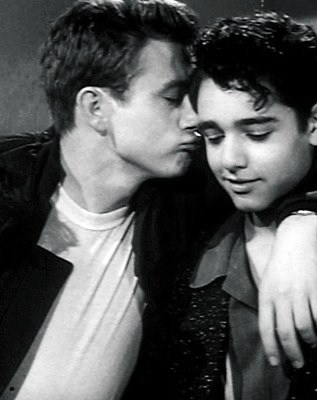
Más sobre Rebel Without A Cause
7: Morris Kight Square

In 1958, Kight moved to Los Angeles, where he was the founder or co-founder of many gay and lesbian organizations. The first such organization was the Gay Liberation Front (GLF) in October 1969, the third GLF in the country (after New York and Berkeley). The name was used to show solidarity with the Vietnamese National Liberation Front. By the next year, there were over 350 GLF organizations around the country.[2]
He also co-founded Christopher Street West gay pride parade in Los Angeles in 1970, Aid For AIDS in 1983, and the Gay Community Center in 1971, (now the Los Angeles Gay and Lesbian Center), the Stonewall Democratic Club in 1975, and many others.[5] Kight remarked that creating the Community Center was the achievement of which he was most proud.
Kight brought his experiences in political action into the realm of gay rights. One of the first actions by the LA GLF was against a local eatery called Barney's Beanery. The restaurant, located in West Hollywood, not only had a sign above bar that said “Fagots [sic] Stay Out”, but also printed up matchbook covers with the same saying. Kight, along withTroy Perry and 100 activists protested outside, sending in protesters occasionally to order coffee and take up space at the tables. The protest was initially successful - the owner eventually handed Kight the sign in front of news cameras. But after the media left the owner replaced the sign, where it remained until West Hollywood's first lesbian mayor, Valerie Terrigno, took it down when the city council passed an anti-discrimination ordinance. Perry vowed at the initial protest to never set foot in the place again until the owner apologized, which finally happened in 2005. The new owner, David Houston, has apologized and, among other methods to reach out to the gay community, holds monthly lunches for disadvantaged gay youth.[6]
He served on the County of Los Angeles Human Relations Commission for two decades.
In 2003 the City of Los Angeles dedicated the corner of Hollywood Boulevard and McCadden Place, in Hollywood, California as "Morris Kight Square." This location was selected as it was the stepping off point for Christopher Street West, the very first street-closing gay pride parade in the world.
Más sobre Morris Kight Square
8: The Black Cat Tavern -1967

5 patrol cars, containing 2 uniformed officers each, were brought from a near-by side street where they had been parked for sometime and the individuals arrested were taken to the newly opened Rampart St. Police Station. 3 bartenders were among those arrested.
This created a riot in the immediate area that soon expanded. Several days later, this police action incited a civil demonstration of over 200 attendees to protest the raids. The demonstration was organized by a group called PRIDE (Personal Rights in Defense and Education). The protest was met by squadrons of armed policemen. Two of the men arrested for kissing were later convicted under state law and registered as sex offenders. The men appealed, asserting their right of equal protection under the law, but the U.S. Supreme Court did not accept their case.
It was from this event that the publication The Advocate began as a newspaper for PRIDE (Personal Rights in Defense and Education). Together the raid on the Black Cat Tavern and later the raid on The Patch in August 1968 inspired the formation of the Metropolitan Community Church.
These events happened two years prior to Stonewall.
On November 7, 2008, the site was declared a Los Angeles Historic-Cultural Monument.
On November 30, 2012 a restaurant opened under the same moniker and tries to embrace its place in LGBT history with historical photos on the walls.
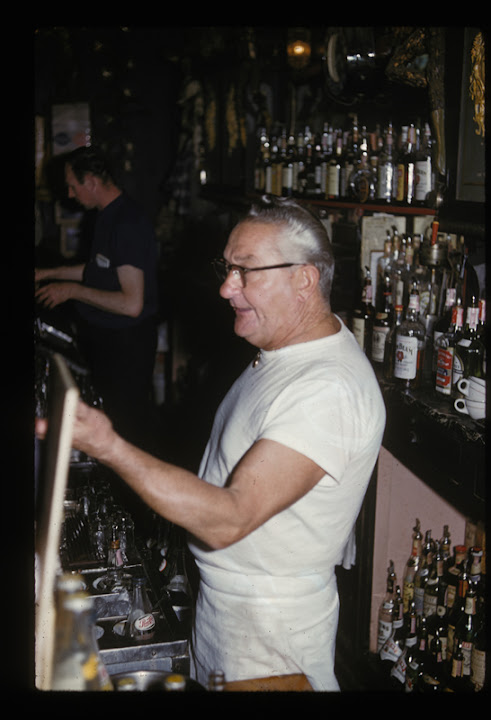
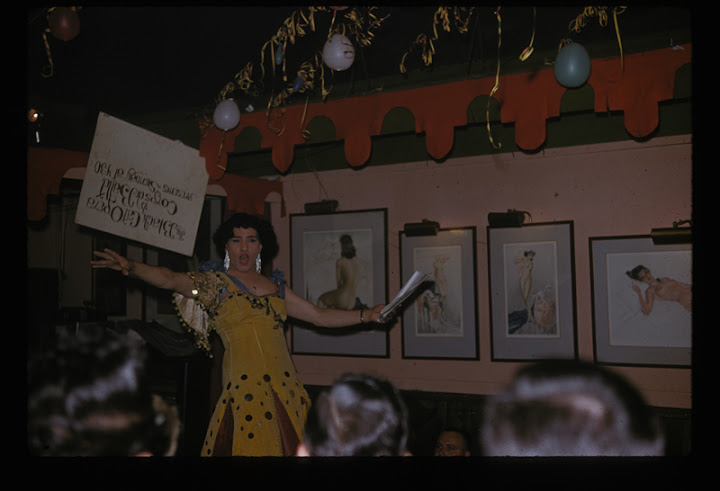
Más sobre The Black Cat Tavern -1967
9: The AT Center -1969
They attempted to have their meeting listed in the Los Angeles AA directory; however, AA would not recognize any "closed," meeting, such as a gay/lesbian only meeting. The organizers subscribed to AA tenets, traditions, and meeting format with the permission of AA, however AA requested that the meeting not use the Alcoholic Anonymous name.
AA did allow the use of their materials and guidelines, only requesting a credit line on copies. The organizers subsequently chose the name "Alcoholics Together" also known as AT. In 1971, the organization opened the "AT Center" a location for meetings, AT meetings quickly expanded and unaffiliated AT meetings spread nationally.
The AT Center continues to provide a variety of meetings for gays and lesbians alcoholics.
Más sobre The AT Center -1969
10: Protest of Restaurant - 1969

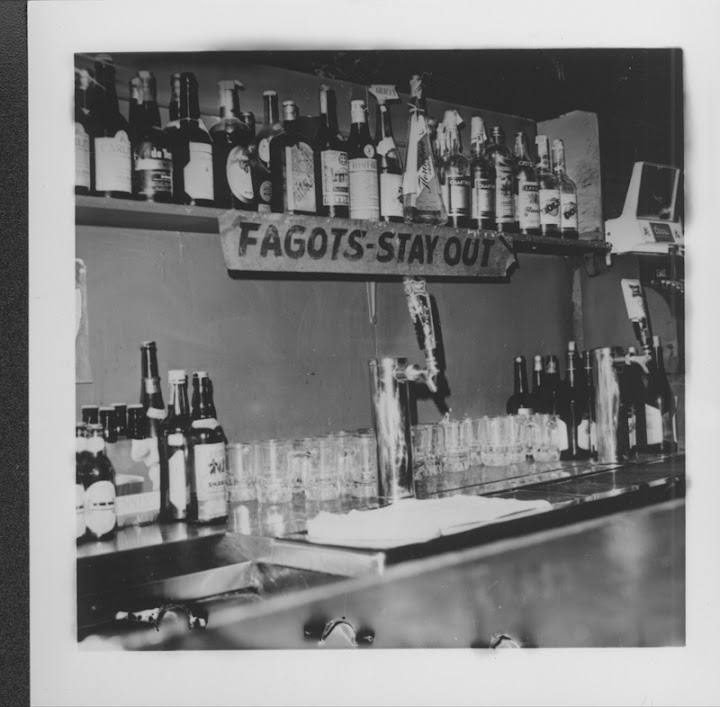
Más sobre Protest of Restaurant - 1969
11: LA's 1st Gay Pride Parade - 1970
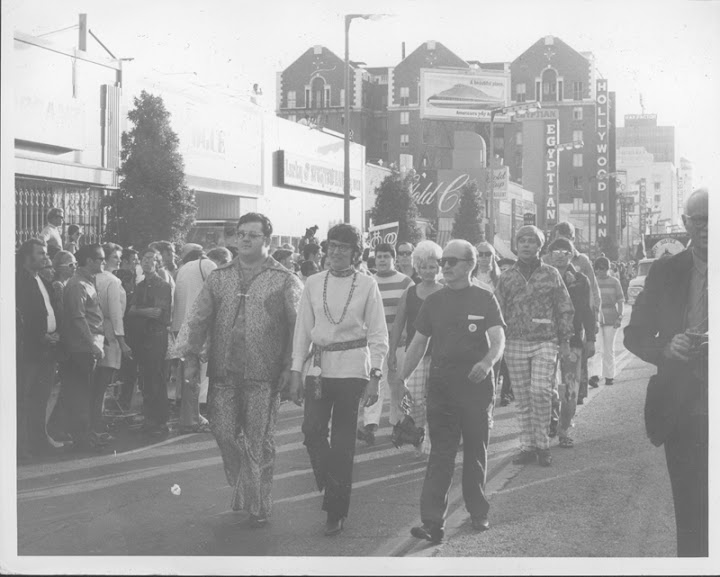
The parade was an opportunity to be proud, see and be seen, and experience, in a public setting, that you were not alone. The parade kicked off with a VW Microbus playing some recordings of marches over an amplification system. The order ran the gamut of just about anything you could name, from the Advocate Magazine’s float with a carload of men in swimsuits, to a conservative gay group in business suits from extremely conservative Orange County.
The Gay Liberation Front came marching down the street carrying banners and shouting, "Two, four, six, eight, gay is just as good as straight." Another organization marching was a group of friends carrying a large sign reading, "Heterosexuals for Homosexual Freedom." It was a direct, welcome, and reassuring gesture.
What they didn’t know at the time was that while other cities were hosting marches, it was Los Angeles that held the world’s first LGBT Pride Parade. The success of the 1970 parade led immediately to talk of making the parade an annual event. The 1971 and 1972 parades had entries that created controversies; and disagreements within the steering committee lead to no parade being produced in 1973.
Más sobre LA's 1st Gay Pride Parade - 1970
12: Tom of Finland House -1970's
The site now houses of the Tom of Finland Foundation, its also one of the earliest Residential Structures in Echo Park. Tom of Finland was identified by the Museum of Modern Art as one of the 10 most influential artists of the 20th Century, recognized for his distinctive Erotica character which transferred a primarily Gay oriented Artistic style to the broader culture.
1421 Laveta Terrace
Más sobre Tom of Finland House -1970's
13: Key Club - 1970's

TODAY: Dentist Office.
Más sobre Key Club - 1970's
14: Don's Male Box - 1970's

Gay leather bar
A 1971 AD stated: Open 4pm - 2am; Sat - Sun 2am - 4am (Coffee Hours)
NOW: 4100 Bar, no longer a gay bar, but the structure still remains,
Más sobre Don's Male Box - 1970's
15: GAY'M -1970's

4007 Sunset
TODAY: "Circus of Books" and furniture store.
Más sobre GAY'M -1970's
16: The Bunkhouse - 1970's

"A Western look with a leather taste."
NOW: A gay-ish/ hipster bar called The Virgil.
Más sobre The Bunkhouse - 1970's
17: Goliath's -1970's

Club with "4 Stages, 3 Screens, Male Nude Dancers"
NOW: a hot wings joint.
Más sobre Goliath's -1970's
18: The Hanged Man - 1970's

Advertised as John and Jack, the Hanged Man offered a Draft Beer Bust on Sundays and Pool Tournaments on Tuesdays...
NOW: The Bullet, gay bar
10522 Burbank Blvd.
Más sobre The Hanged Man - 1970's
19: Jewel's Catch One - 1972

Más sobre Jewel's Catch One - 1972
20: Beth Chayim Chadashim - 1972
Más sobre Beth Chayim Chadashim - 1972
21: Studio One - 1975
West Hollywood's Studio One was a HOT club for many years, had the best Halloween parties, sponsored the first Gay Night parties at Disneyland, Knott's Berry Farm and Magic Mountain. Staff ran around in tight satin short shorts. The Backlot was a show room where all the celebrities came for dinner shows. One of the pioneers of disco light shows in the dance room. The Pegasus winged horse and Studio One surrounded by a circle of stars were its symbols.
More...
NOW: Factory (Club)
Más sobre Studio One - 1975
22: Sal Mineo

Más sobre Sal Mineo
23: Protest - 1979
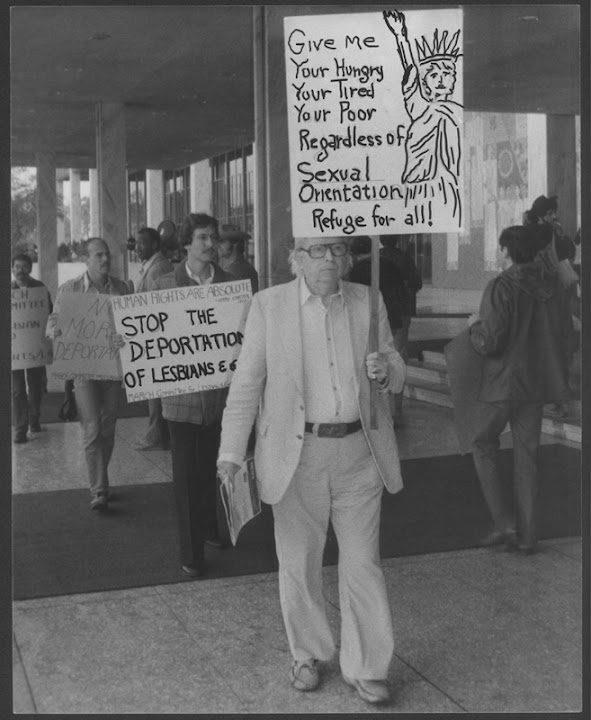
Morris Kight protesting the Anthony Sullivan deportation hearing at the Federal Building in Westwood.
Richard Adams was born in Manila in the Philippines. His family moved to the United States when he was 12, and he grew up in Long Prairie, Minnesota. He studied liberal arts at the University of Minnesota. Adams became a naturalized U.S. citizen in 1968 and lived in Los Angeles, California when he met Australian citizen Anthony Corbett "Tony" Sullivan in 1971. They were married along with five other gay couples by Boulder County Clerk Clela Rorex in Boulder, Colorado on April 21, 1975.[3]
In 1975, the couple applied with the Immigration and Naturalization Service for Sullivan to be granted permanent residency as a citizen's spouse. The petition was initially denied, with a letter stating that "[Adams and Sullivan] have failed to establish that a bona fide marital relationship can exist between two faggots."[4] A revised letter was later sent after they filed a formal protest, explaining that "[a] marriage between two males is invalid for immigration purposes and cannot be considered a bona fide marital relationship since neither party to the marriage can perform the female functions in marriage."[5]
They sued the INS in 1979, but a federal district judge upheld the INS decision. They also lost their appeals. They later filed a second suit arguing that Sullivan's deportation after the couple had been together for 8 years constituted an "extreme hardship." The U.S. 9th Circuit Court of Appeals rejected their claims, making it possible for Sullivan to be deported. Following that loss, they traveled in Europe for a year, but they eventually returned to the US and stopped doing high-profile activism to avoid attention from immigration authorities. Adams worked as an administrator for a law firm until his retirement in 2010. After retirement, Adams and Sullivan made some appearances at events supporting gay marriage. They are featured in the documentary Limited Partnership, which is scheduled for release by Tesseract Films in 2013.
Adams died in Los Angeles after a short illness.
Más sobre Protest - 1979
24: Great Hall-Long Hall -1984
The grounds the buildings are strong examples of Spanish Colonial revival architecture and because they were built by the Work Projects Administration (WPA), the Depression-era government-funded department that constructed many highways, parks and public buildings across the nation.
The Great Hall-Long Hall buildings were where organizational meetings were held in 1984 to incorporate the city.
It was also the place where the Los Angeles chapter of ACT UP (AIDS Coalition to Unleash Power) was formed and met weekly for 10 years from 1987-1996. ACT UP is an international advocacy group instrumental in pushing the United States government to act on the AIDS crisis and find effective treatment medication in the late 1980s and early 1990s.
Longtime ACT UP member Kevin Farrell took the day off from work to attend the meeting. Great Hall was the “perfect location” for the group’s meetings as West Hollywood was the epicenter of the AIDS epidemic in the 1980s, Farrell said.
“The building has earned a critical place in West Hollywood history and in LGBT history,” he said.
To make the designation official, the Keeper of the National Register of Historic Places in Washington D.C. must approve the addition of Great Hall-Long Hall to the list of approximately 80,000 places nationwide.
http://www.wehoville.com/2013/05/01/great-hall-long-hall-buildings-approved-to-national-register-of-historic-places/
Más sobre Great Hall-Long Hall -1984